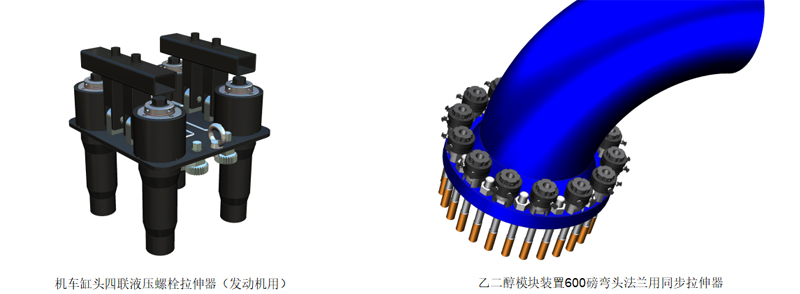Recently, the flange of the reactor device on our petrochemical flange integrity management project site is being tightly reinstalled. We can see from the pictures sent back by our engineering department on site that the construction team is using the BOLTING four synchronous hydraulic bolt tensioner to pre tighten the bolts of the reactor device. So why is the advantage of choosing a hydraulic bolt tensioner for synchronous pre tightening in the reactor bolt pre tightening scheme? What needs to be noted?
When it comes to advantages, it is necessary to compare them with other solutions. We know that the bolt specifications and required pre tightening force for the reaction petrochemical reactor are relatively large. At present, there are only two ways to provide such a large and accurate pre tightening method: one is a synchronous pre tightening scheme with a high torque hydraulic wrench; A synchronous pre tightening scheme for hydraulic bolt stretchers. The comparison between these two schemes is actually the way they work. The pre tightening principle of a hydraulic torque wrench is to drive the working head of the wrench to rotate and tighten the bolt through hydraulic pressure, while the hydraulic bolt tensioner stretches the bolt to a certain elongation (within the elastic range of the material) through hydraulic pressure and elastic deformation in the axial direction, making it easy for the nut to recover its deformation and apply load after installation to the bottom. Obviously, the rotational tightening stress and bending moment of a hydraulic wrench will result in more torque loss, while the axial stretching hydraulic bolt tensioner will result in less torque loss. The actual torque applied to the bolt is more precise and uniform, and the effect of pre tightening the high torque bolt in the reactor is more reliable.

The configuration of the reactor flange bolt hydraulic bolt tensioner scheme should be noted that the number of flanges is relatively small, and if full coverage can be achieved, synchronous pre tightening with full coverage should be selected; If not, choose 50% coverage. Because the coverage of hydraulic bolt stretchers is not as high as that of hydraulic wrenches, which can only achieve a maximum of four synchronizations, hydraulic bolt stretchers can achieve a maximum of 100% coverage. The higher the synchronization degree, the more uniform the distribution of pre tightening force, and the better the effect.
In on-site construction, it is best to scientifically calculate the pre tensioning force of bolts based on the on-site bolt working conditions and the actual parameters of the bolt tensioner.
During the operation, ensure the cleanliness of the flange and bolt surfaces to avoid dirt, dust, and other factors that may affect the pre tightening effect. During the disassembly process, the sealing components of the stretcher should also be protected to avoid damage.
Before pre tightening, check the size, shape, surface quality, etc. of bolts and flanges to ensure compliance with design requirements. If there are problems such as wear and deformation, they should be replaced or repaired.
During the operation, follow the safety operating procedures of the hydraulic bolt tensioner and hydraulic system to ensure personal and equipment safety. Pay attention to preventing accidents such as hydraulic oil leakage and high pressure injuries.
Regularly maintain and inspect the hydraulic bolt tensioner and hydraulic system to ensure stable and reliable equipment performance. Replace worn and damaged components in a timely manner to ensure the service life and safety of the hydraulic bolt tensioner.